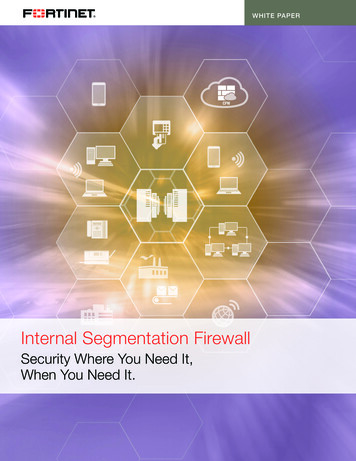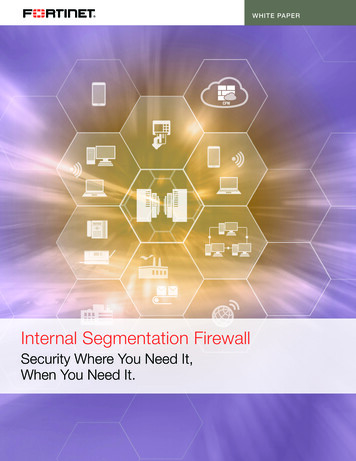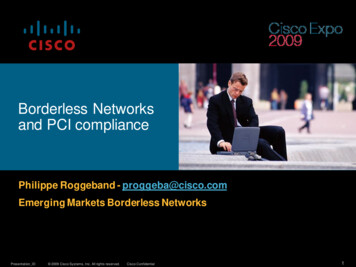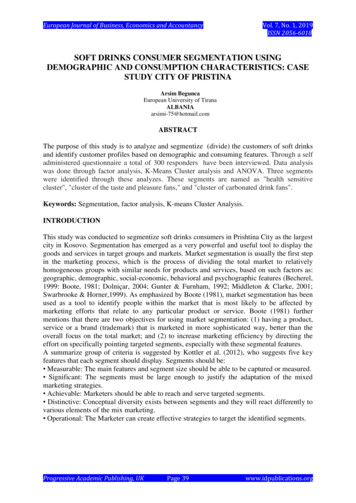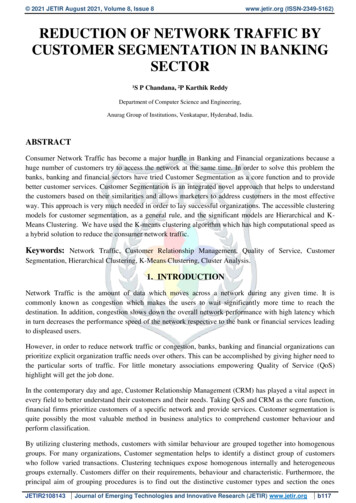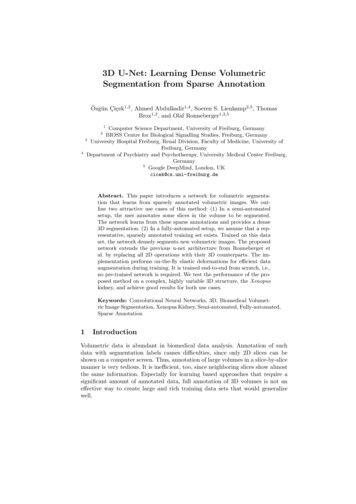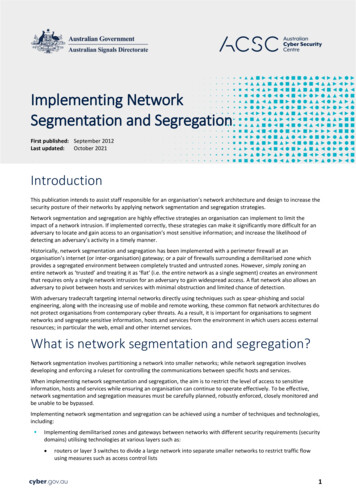
Transcription
Implementing NetworkSegmentation and SegregationFirst published: September 2012Last updated:October 2021IntroductionThis publication intends to assist staff responsible for an organisation’s network architecture and design to increase thesecurity posture of their networks by applying network segmentation and segregation strategies.Network segmentation and segregation are highly effective strategies an organisation can implement to limit theimpact of a network intrusion. If implemented correctly, these strategies can make it significantly more difficult for anadversary to locate and gain access to an organisation’s most sensitive information; and increase the likelihood ofdetecting an adversary’s activity in a timely manner.Historically, network segmentation and segregation has been implemented with a perimeter firewall at anorganisation’s internet (or inter-organisation) gateway; or a pair of firewalls surrounding a demilitarised zone whichprovides a segregated environment between completely trusted and untrusted zones. However, simply zoning anentire network as ‘trusted’ and treating it as ‘flat’ (i.e. the entire network as a single segment) creates an environmentthat requires only a single network intrusion for an adversary to gain widespread access. A flat network also allows anadversary to pivot between hosts and services with minimal obstruction and limited chance of detection.With adversary tradecraft targeting internal networks directly using techniques such as spear-phishing and socialengineering, along with the increasing use of mobile and remote working, these common flat network architectures donot protect organisations from contemporary cyber threats. As a result, it is important for organisations to segmentnetworks and segregate sensitive information, hosts and services from the environment in which users access externalresources; in particular the web, email and other internet services.What is network segmentation and segregation?Network segmentation involves partitioning a network into smaller networks; while network segregation involvesdeveloping and enforcing a ruleset for controlling the communications between specific hosts and services.When implementing network segmentation and segregation, the aim is to restrict the level of access to sensitiveinformation, hosts and services while ensuring an organisation can continue to operate effectively. To be effective,network segmentation and segregation measures must be carefully planned, robustly enforced, closely monitored andbe unable to be bypassed.Implementing network segmentation and segregation can be achieved using a number of techniques and technologies,including: Implementing demilitarised zones and gateways between networks with different security requirements (securitydomains) utilising technologies at various layers such as: routers or layer 3 switches to divide a large network into separate smaller networks to restrict traffic flowusing measures such as access control lists1
virtualised networking and routing protocols, including Virtual Local Area Networks and Virtual Routing andForwarding to segment the network virtual machines, containers and virtual functions to isolate activities of different trust or threat levels (such asaccessing the internet or email, or performing privileged administrative tasks) virtual hosts, virtual switching, cloud tenancies and managed security groups to segregate and segmentapplications, data and other services host-based security and firewall software to filter network traffic at the host level network firewalls and security appliances between networks to filter network traffic network access controls to control the devices which can access networks application and service firewalls and proxies (or service brokers) to allow only approved communicationsbetween applications and services in different networks user and service authentication and authorisation, including multi-factor authentication and policy-basedaccess controls to enforce least privilege data diodes and one-way transfer devices to enforce the directionality of data flows between networks content filtering techniques including recursive decomposition, validation, verification and sanitisation tocomprehensively assure network and application traffic flows. Implementing server and domain isolation using Internet Protocol Security (IPsec). Implementing storage-based segmentation and filtering using technologies such as disk and volume encryptionand Logical Unit Number masking. For extremely sensitive network connections, implementing Cross Domain Solutions or other technologiesrecommended by the Australian Cyber Security Centre (ACSC).To be successful, implementation of these techniques and technologies must be driven by a network architecture basedon achieving organisational business and security requirements. It is vital that network, system and security architectswork together with business analysts and customers to ensure that an accurate and considered strategy is adopted.Why is network segmentation and segregationimportant?Once an adversary compromises a network, usually through the compromise of a host under the control of a legitimateuser by means of social engineering, they will attempt to move around the network to locate and access sensitiveinformation, hosts and services. In order to minimise the impact of such a network intrusion, it should be as hard aspossible for the adversary to find and access such information, move undetected around the network and removeinformation from the network.An adversary may attempt to make connections directly from a compromised host to a more sensitive host using toolsand techniques at their disposal. For example, if an adversary has initially compromised a workstation, they may seek tocreate a remote connection to a server, map a network resource or use legitimate network administration tools inorder to access sensitive information or execute malicious code on that server. This is particularly common when anadversary targets an organisation’s authentication server. Properly planned and implemented network segmentationand segregation is a key security measure to assist in preventing such activities from occurring. Example mitigationsinclude explicitly disallowing remote desktop connections or the use of common network administration tools fromuser workstations (as most users do not require such functionality), configuring servers to limit the sharing of files, andrestricting servers’ ability to communicate via remote connections.2
Network segmentation and segregation can also assist security personnel in their duties. Organisations implementingthese measures should consider the audit and alerting capabilities of candidate technologies, as these features mayprove critical in identifying a network intrusion and ensuring timely incident response activities. A mature segmentedand segregated environment will also allow an organisation to better focus their auditing and alerting strategies on aprioritised subset of attack vectors informed by the approved network access methods. Additionally, it can provide away to isolate compromised hosts or networks in a timely manner following a network intrusion.How can network segmentation and segregationbe implemented?Regardless of the technologies chosen for network segmentation and segregation, there are five common themes forbest practice implementations: Apply technologies at more than just the network layer. Each host and network should be segmented andsegregated, where possible, at the lowest level that can be practically managed. In most cases, this applies fromthe data link layer up to and including the application layer; however, in particularly sensitive environments,physical isolation may be appropriate. Host-based and network-wide measures should be deployed in acomplementary manner and be centrally monitored. It is not sufficient to simply implement a firewall or securityappliance as the only security measure. Use the principles of least privilege and need‐to‐know. If a host, service or network doesn’t need to communicatewith another host, service or network, it should not be allowed to. If a host, service or network only needs to talkto another host, service or network on a specific port or protocol, and nothing else, it should be restricted to this.Adopting these principles across a network will complement the minimisation of user privileges and significantlyincrease the overall security posture of the environment. Separate hosts and networks based on their sensitivity or criticality to business operations. This may include usingdifferent hardware or platforms depending on different security classifications, security domains oravailability/integrity requirements for certain hosts or networks. In particular, separate management networksand consider physically isolating out-of-band management networks for sensitive environments. Identify, authenticate and authorise access by all entities to all other entities. All users, hosts and services shouldhave their access to all other users, hosts and services restricted to only those required to perform theirdesignated duties or functions. All legacy or local services which bypass or downgrade the strength ofidentification, authentication and authorisation services should be disabled wherever possible and have their useclosely monitored. Implement a list of approved network traffic instead of a list of unapproved network traffic. Only allow access forknown good network traffic (i.e. that which is identified, authenticated and authorised), rather than blockingaccess to known bad network traffic (e.g. blocking a specific address or service). Not only will this result in asuperior security policy, it will also significantly improve an organisation’s capacity to detect and assess potentialnetwork intrusions.The following types of traffic flow filtering techniques should be considered when implementing network segmentationand segregation. As stated above, these filtering techniques will be significantly more effective if implemented using anapproach that specifically allows traffic rather than specifically blocks traffic: Logical access restrictions of network traffic such as: network layer filtering that restricts which hosts are able to communicate with other hosts based on InternetProtocol and route information3
state‐based filtering that restricts which hosts are able to communicate with other hosts based on theirintended function or current state of operation port and/or protocol level filtering that restricts the number and type of services that each host can use tocommunicate with other hosts. Authentication filtering to restrict access to hosts, services and networks based on strong authentication,commonly implemented using public key cryptography, such as certificate-based IPsec. Application filtering to filter the content of communications between hosts and networks at the application layer,commonly implemented using email and web content filtering, intrusion prevention systems, and web applicationor XML firewalls. For particularly sensitive environments, it may also be appropriate to implement physical isolation betweennetworks. Where limited interaction between physically-isolated networks is necessary, one or more of thefollowing may be required: bespoke or tailored security device High Assurance product, or Cross Domain Solution.As with any security strategy, network segmentation and segregation implementations must be adapted whensignificant changes occur to an organisation’s network. Additionally, environmental changes such as new businessfunctions and evolving cyber threats will necessitate reviews of an organisation’s security posture and networkarchitecture to ensure appropriate mitigation strategies are applied.Example implementations of networksegmentation and segregationSegmenting a network to protect key hostsIn this scenario an organisation had decided to segment their network to protect key hosts from a network intrusion. Indoing so they implemented the following security measures: compiled an inventory of key hosts documenting their sensitivity and any necessary communications with suchhosts planned the introduction of security measures in a schedule that was achievable with the resources allocatedensuring sufficient testing prior to deployment restricted logical network connectivity to key hosts to only those ports and protocols that were essential only allowed connections to be established from more trusted to less trusted zones and not vice versa (with theexception of necessary user access to application interfaces) approve specific application layer content so that only that content was allowed to flow between different trustzones implemented multi-factor authentication in addition to using a separate set of credentials for users and services iftheir function was more sensitive than other users or services sharing the same host or network minimised the use of implicit trust relationships between hosts in the same and different trust zones (the trustrelationships defined across different trust zones were implemented such that each side of the trust relationshipauthenticated and authorised the other)4
implemented web, email and file content filtering for connections to external organisations and the internet todetect and sanitise potentially malicious content applied intrusion prevention and host-based antivirus to detect and quarantine identified malicious content implemented centralised logging, alerting, monitoring and auditing capabilities which were the responsibility of adedicated security operations team.The above list is not an exhaustive set of security measures; however, it is a realistic overview which demonstrates thatnetwork segmentation and segregation must be considered at all layers to be effective. Implementing a secure networkarchitecture is never as simple as implementing a gateway firewall with restrictive access control lists.Segregating high-risk applications from a networkIn this scenario an organisation had identified that most of their network contained sensitive information andsegmenting the network or segregating all of that information was not cost-effective. Instead, the organisation chose tosegregate high-risk applications (i.e. web browsers, email clients and content management systems) from the rest ofthe network. In doing so, they implemented the following security measures to maintain business requirements whilereducing the risk of a successful network intrusion: Users requiring internet access launched a remote desktop application on their corporate workstation to access avirtual desktop and authenticated with a user account used only for that purpose. This virtual desktop was servedfrom a dedicated server hosted in a different network segment within a different authentication domain. Thisdedicated remote desktop allowed users to conduct high-risk activities such as web browsing and reading emailswhile limiting the utility of a single compromised application to an adversary. Users requiring access to high-risk applications launched a local virtualisation application to run a hardened virtualhost which connected to a less-trusted remote environment which was protected by a layered security gatewaythat broke apart and abstracted all necessary communications protocols between high-risk applications and theorganisation’s corporate network.Summary of example implementationsThe key takeaway from both approaches was that users did not store or process potentially malicious data directly ontheir corporate workstation or use the corporate servers which were relied upon for sensitive and business-criticalfunctions. Each user’s interaction was with a remote desktop or application and, if required, output was sent back tothe user through a sufficiently structured and limited capability that prevented malicious code from executing orpropagating throughout the corporate network.It is important to remember that when implementing security measures an organisation will incur a resource cost toensure that the additional systems are appropriately maintained. As with other technology assets, these securitymeasures should be managed and monitored, with security patches applied as soon as possible after release.Finally, it is recommended that all web browsing environments should be non‐persistent, rigorously hardened andsubject to regular technical security assessments. Therefore, if the web browsing environment does becomecompromised with malicious code, the infection is quickly removed when the user completes their web browsingsession.Further informationThe Information Security Manual is a cyber security framework that organisations can apply to protect their systemsand data from cyber threats. The advice in the Strategies to Mitigate Cyber Security Incidents, along with its EssentialEight, complements this framework.5
Contact detailsIf you have any questions regarding this guidance you can write to us or call us on 1300 CYBER1 (1300 292 371).6
Historically, network segmentation and segregation has been implemented with a perimeter firewall at an organisation's internet (or inter-organisation) gateway; or a pair of firewalls surrounding a demilitarised zone which provides a segregated environment between completely trusted and untrusted zones. However, simply zoning an
